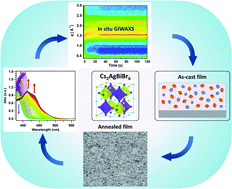Impact of processing conditions on the film formation of lead-free halide double perovskite Cs2AgBiBr6†
Abstract
Lead-free halide double perovskites with enhanced stability have gained attention as a promising environmentally friendly alternative to lead-based halide perovskites. Amongst different halide double perovskites, Cs2AgBiBr6 has shown attractive optoelectronic properties and stability, making it a promising candidate for stable high-efficiency optoelectronic devices. Motivated by a data mining effort, we present here the effects of different processing strategies on the microstructure and thin-film formation dynamics of Cs2AgBiBr6. We apply some of the most successfully used solvent engineering approaches from the halide perovskite research to halide double perovskites, namely antisolvent- and additive-assisted synthesis. Using in situ spectroscopy and diffraction, the film formation of Cs2AgBiBr6 is investigated during spin coating, and the subsequent post-deposition thermal annealing. Dropping antisolvents during spin coating induces immediate supersaturation and crystallization of the wet film, whereas the time of dropping the antisolvent has implications on the film formation dynamics and the final microstructure. For additive (HBr)-assisted synthesis, we show how the addition of HBr affects colloid formation in solution and thus influences the crystallization pathway during thin-film processing. Finally, HBr additive simplifies synthesis in that it doesn't require solution and substrate preheating to obtain pinhole-free films even with higher thickness.

- This article is part of the themed collections: 2022 Journal of Materials Chemistry A Most Popular Articles and Journal of Materials Chemistry A Emerging Investigators


 Please wait while we load your content...
Please wait while we load your content...
